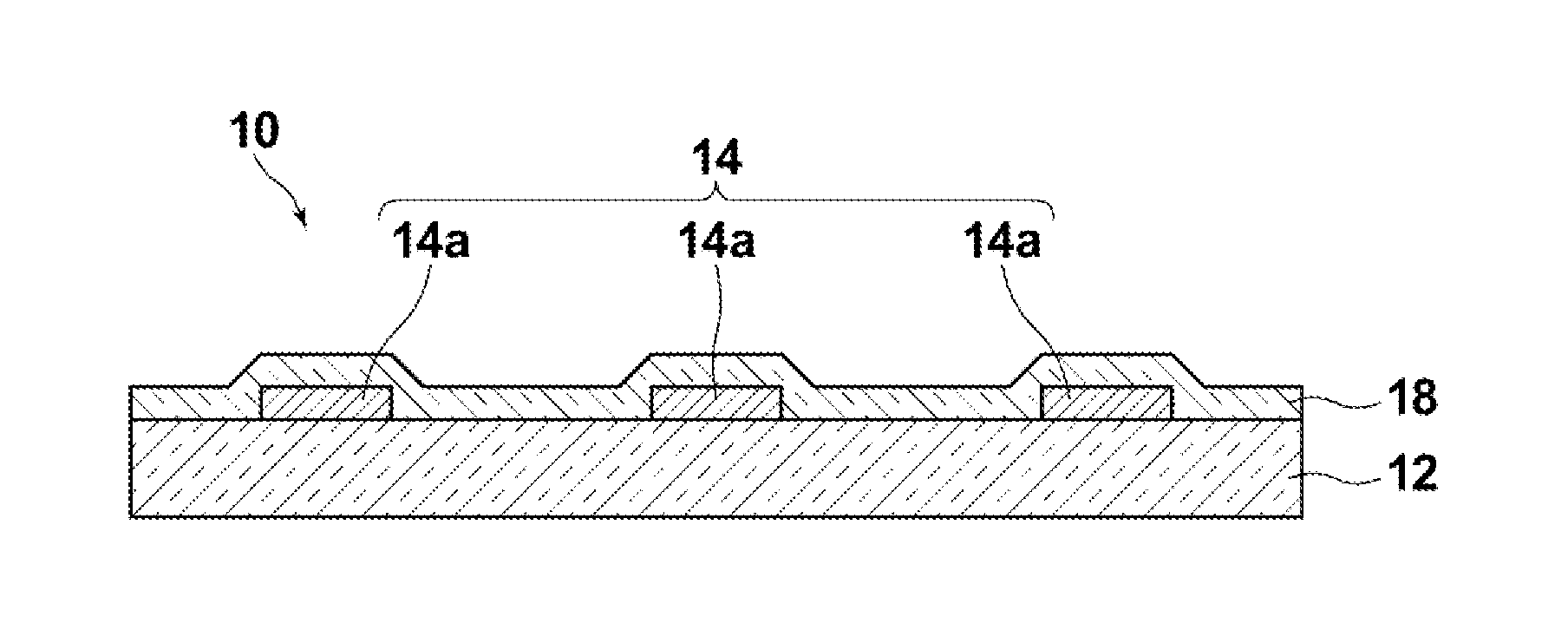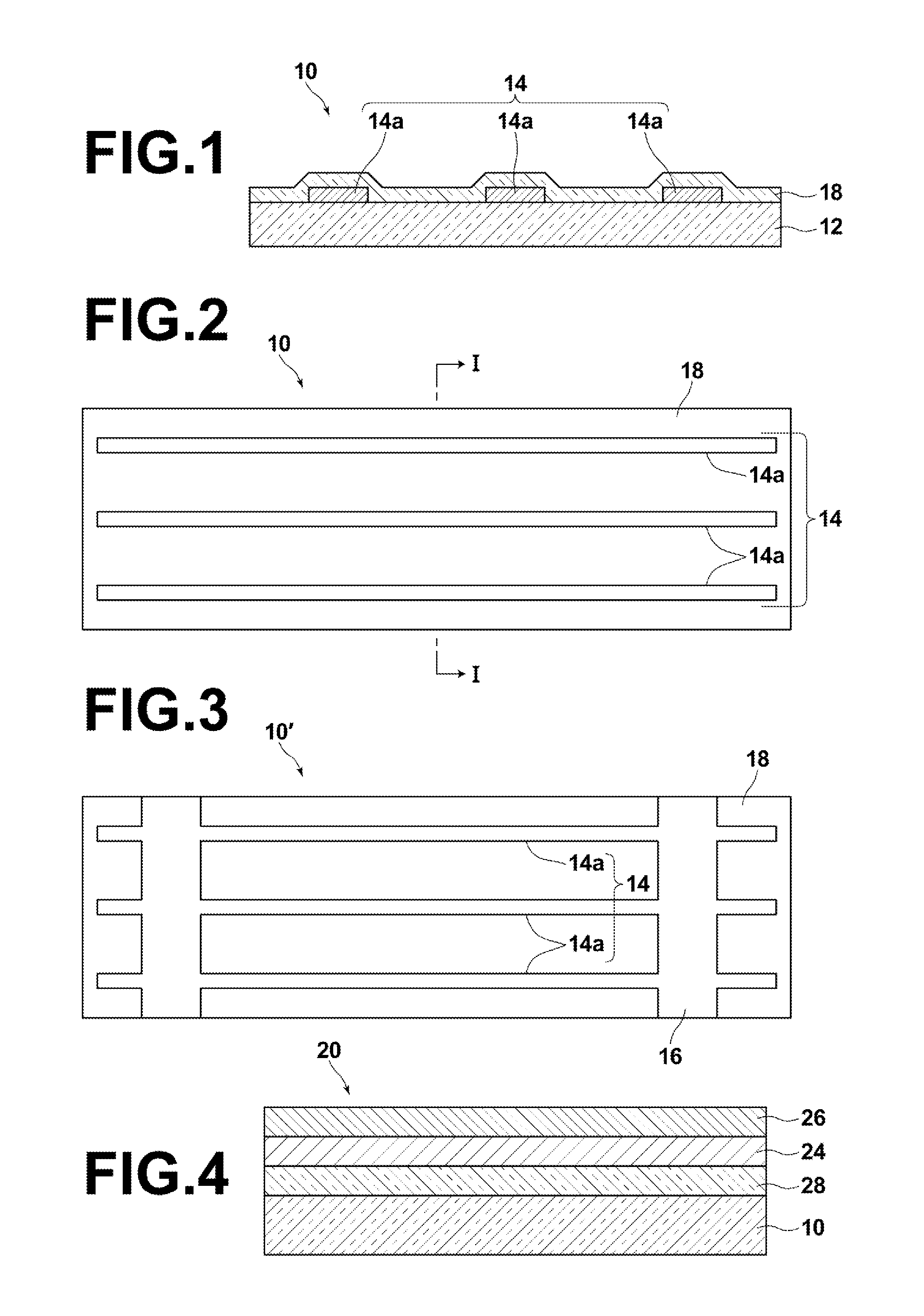Transparent conductive film, method of producing the same, flexible organic electronic device, and organic thin-film solar battery
- Summary
- Abstract
- Description
- Claims
- Application Information
AI Technical Summary
Benefits of technology
Problems solved by technology
Method used
Image
Examples
examples
[0145]Hereinafter, the present invention is more specifically described using examples. The materials, amounts of the materials used, ratios, contents of treatments, procedures, etc., shown in the following examples can be modified as appropriate without departing from the spirit of the invention. Therefore, the scope of the invention is not limited to the specific examples shown below.
example 1-2
Formation of Conductive Stripe
[0151]A copper stripe film was produced in the same manner as in Example 1 (the transparent conductive film F-1), except that the metal material forming the conductive stripe was changed from silver to copper.
Formation of Conductive Polymer Layer
[0152]On the surface of the thus formed film, an aqueous dispersion of polyethylenedioxythiophene / polystyrene sulfonate (abbreviated as PEDOT-PSS) (ORGACON S-305, available from Agfa) was spin-coated. Then, this film was dried by heating at 110° C. for 20 minutes to form a conductive polymer layer. The thickness of the conductive polymer layer was 100 nm.
[0153]In this manner, a transparent conductive film (F-6) of Example 1-2 shown in Table 1 was obtained.
[0154]Separately from this, the conductive polymer layer was formed in the same manner as described above on a 25 mm×25 mm PET film without the conductive stripe vapor-deposited thereon, and the surface resistance value was found to be 220Ω / □. Based on this res...
examples 4 to 6
Production of Transparent Conductive Film
[0165]Transparent conductive films (F-11 to F-13) were produced in the same manner as the production of the transparent conductive film (F-1) of Example 1, except that the mask was slid during the vapor deposition of silver. The holder of the mask was movable, and the sliding was achieved using a stepper motor for a vacuum chamber. The sliding direction was perpendicular to the stripe in the plane of the mask. The sliding width was 0.05 mm. The film thickness and the line width of the formed conductive stripe was as shown in Table 2. The line width was increased by the sliding width, and the cross-section of the stripe in the perpendicular direction had an isosceles trapezoidal shape where the thickness decreased toward each end.
Production of Organic Thin-Film Solar Battery
[0166]Using the transparent conductive films (F-11 to F-13), organic thin-film solar batteries (P-11 to P-13) of Examples 4 to 6 were produced in the same manner as in Exam...
PUM
| Property | Measurement | Unit |
|---|---|---|
| Length | aaaaa | aaaaa |
| Length | aaaaa | aaaaa |
| Length | aaaaa | aaaaa |
Abstract
Description
Claims
Application Information
 Login to View More
Login to View More - R&D
- Intellectual Property
- Life Sciences
- Materials
- Tech Scout
- Unparalleled Data Quality
- Higher Quality Content
- 60% Fewer Hallucinations
Browse by: Latest US Patents, China's latest patents, Technical Efficacy Thesaurus, Application Domain, Technology Topic, Popular Technical Reports.
© 2025 PatSnap. All rights reserved.Legal|Privacy policy|Modern Slavery Act Transparency Statement|Sitemap|About US| Contact US: help@patsnap.com


